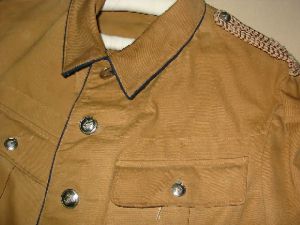|
Figure 1 is based on a
photograph of
Hoofveldkornet
Pieter de Wet, an Officer of the South African
Free Corps shown in the early stages of their formation. He wears a South
West African Landespolizei Südwester hat (see right) with a small imperial
German cockade on the front. His tunic is a very curious item. It is a plain
four pocketed khaki tunic with no shoulder straps and five buttons down the
front. The source of this tunic is unknown as it matches no known uniforms worn by the
Schutztruppe (their tunics had six buttons), South African Union, Boer Republics
or British forces in the area, yet it has been seen worn by several Free Corps
members in different photographs. In the original photograph he has no visible
signs of rank insignia. His riding breeches, gaiters and boots appear to be
Landespolizei issue but maybe Schutztruppe or privately acquired items. His
cartridge bandolier is standard Landespolizei issue.
Pieter de Wet was the brother of the Free Corps
commander Andries De Wit and a cousin of the famous Boer general Cristiaan de
Wet. He joined the Free Corps in German South West Africa upon its
formation and was appointed a Hoofveldkornet
(equivalent of an "Oberleutnant" in the German ranking system). He was however relieved of his position soon after he
led a premature invasion
of South African Union territory.
Figure 2 is based on a
photograph of a Trooper of the South African
Free Corps. Schutztruppe uniforms were issued as standard to other ranks of
the Free Corps. This trooper wears the 1896 Schutztruppe khaki tunic piped in blue and
matching trousers. From the original photograph is it difficult to tell if the
tunic has been striped of its shoulder straps of woven threads in the imperial
German colours but a surviving 1896 Schutztruppe tunic worn by the Free Corps
(see right) shows them still to have been worn by at least some
Boers. His grey felt Südwester hat, edged and with a hatband in
blue, is also standard Schutztruppe issue for German South West
Africa (see right). The cockade on the right side of the
Südwester, may be its original imperial German colours or may be
the unproven "Vierkleur" design. If so, that would be the only
difference between the appearance of this trooper and that of a
regular German Schutztruppe trooper. The brown leather
equipment, ammunition pouches and riding boots are standard Schutztruppe issue.
Figure 3 is based on a
photograph of
Veldkornet Oosthuizen of the South African
Free Corps. He wears a German South West African Landespolizei dark khaki
tunic with four pockets, a green collar and six brass buttons (see right)
fastening the front. This tunic has been stripped of its former shoulder straps
and any previous Landespolizei rank insignia (in the from of pips on the collar
and green bands on the cuffs). Instead rank is shown in the form a
light coloured (probably metallic white) thin strip of lace on each cuff.
Another figure in the original photograph has two parallel strips of thin cuff lace.
It can be postulated therefore that Leutnants or Veldkornets (such as Oosthuizen here) wore
one strip, Hoofveldkornets wore two, and that captains may have worn three.
The rank insignia for majors and upwards is unknown but may have incorporated
the use of thick bands of lace too. On the left breast pocket
of the tunic is a cross shaped medal. From the original photopgraph upon which
this luustration is based it is impossible to positively
identify the medal. It may be one earned in previous Boer
service or possibly an Iron Cross First Class, if so it is one of
the so-called "Hildegard" Orders improvised by the South West African Schutztruppe
during the First World War. There is no record however of Oosthuizen ever
recieving the Hildegard Order. His riding breeches, gaiters and
boots are also Landespolizei issue. From the original photograph
is is unclear if his
Landespolizei Südwester (see right) has a Vierkleur cockade or a brass
imperial German crown (as usually worn by the Landespolizei) pinned on its right hand side. He carries a Landespolizei belt with a
pistol in a holster on the left hand side.
Charl Oosthuizen originally
served in the Boer Republic of Traansvaal's State Artiilery ("Transvaal Staatsartillerie").
According to a 1921 article in the Afrikaans magazine "De Brandwag"
he served as a transport officer for the Schutztruppe in South
West Africa from 1904. From here he transferred to the Free
Corps or more likely the Batterie Hausding
in 1914.
Figure 4 is based on a
photograph of Barend van der Merwe, an Ordinance Officer of the South African
Free Corps. He wears corduroy Schutztruppe field cap with the hatband and
colours of a German ordinance officer, that is black hatband
with red piping. The stiff appearance of the upper part of the
cap shows it still has its wire retaining loop (Barend's cap
actual cap is shown on the left although it appears to have
later lost
its wire loop, and thus its stiff shape). Again he wears a five
buttoned khaki tunic of unknown origin, with four pockets and no
shoulder straps as worn by Fig1. It was perhaps later that Barend was issued his 1896 Schutztruppe tunic as seen on the
left. Certainly the tunics seen in the museum and in the
original photograph upon which this illustration is based, do
not match. He wears khaki trousers and short leather boots which
may well be Schutztruppe issue.
|

SW African Police Südwester
(See
Südwester
Details Page)
Photo Copyright Doppler

Schutztruppe Südwester
(See
Südwester
Details Page)
Photo Copyright Doppler

Schutztruppe 1896 Khaki
Tunic
used by the Free Corps
(See
South African Museums
Collections)
Photo Copyright MC Heunis

Ordinance Officer's Cap
used by the Free Corps
(See
South African Museums
Collections)
Photo Copyright MC Heunis |